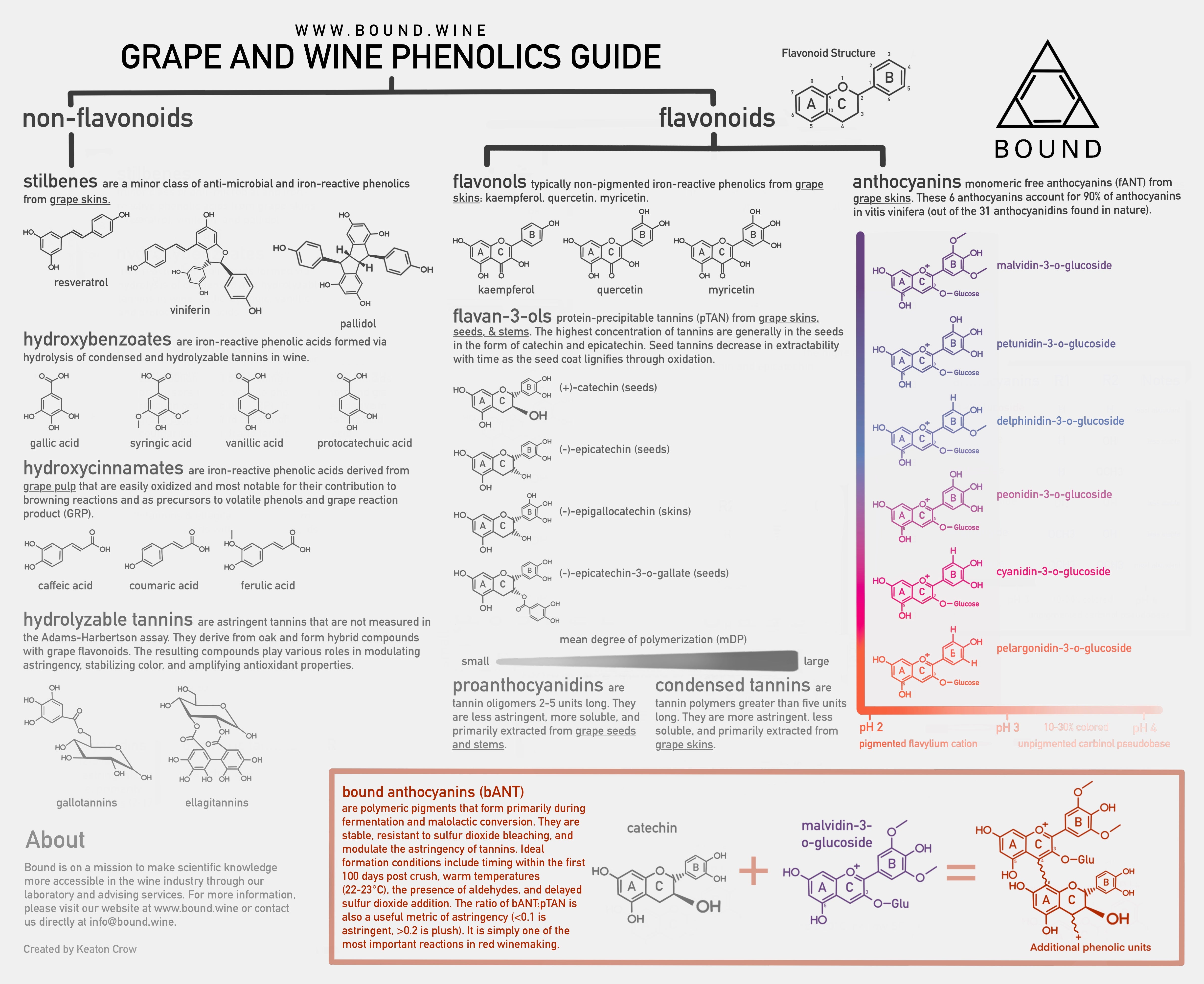

Iron-Reactive Phenolics (IRPs)
 Figure 1. WINEXRAY's representative phenolic profile of a 21-day macerated Bordeaux varietal fermentation (The Future of Winemaking: Honoring the Vision of Professor Roger Boulton, 2022).
Figure 1. WINEXRAY's representative phenolic profile of a 21-day macerated Bordeaux varietal fermentation (The Future of Winemaking: Honoring the Vision of Professor Roger Boulton, 2022).
Iron-Reactive Phenolics (IRPs) are powerful antioxidants that we use to represent non-pigmented phenolics in wine. The assay is most comparable to the Total Phenolics Index (TPI), with IRPs consisting of tannins and several different families of non-flavonoid phenolics including hydroxycinnamates, hydroxybenzoates, stilbenes, and hydrolyzable tannins. Most of their non-flavonoid fraction are present in the pulp making them ubiquitous between red and white wines (Singleton et al., 1978). In practice, we see that IRPs are very stable, likely only decreasing 10-20% within the first year due to its protein-precipitable tannin fraction.
IRPs get their name because they contain more than one hydroxyl (OH) group and react with iron chloride. Their specific chemistry also makes them powerful and persistent antioxidants in wine. As Dr. Vernon Singleton established in the 1970s, IRPs participate in a cascading antioxidant reaction called regenerative polymerization (Singleton et al., 1979). The teachings from his work are highly consequential to our understanding of phenolic reactivity (a wine’s latent antioxidant potential) and a wine's reductive strength (a wine’s active antioxidant strength). This reaction is also highly influenced by temperature, pH, and light which further informs our decision-making in the vineyard and the cellar. IRPs are a highly consequential yet lesser-known fraction of grape and wine phenolics.
Non-flavonoid IRPs (hydroxycinnamates, hydroxybenzoates, stilbenes, and hydrolyzable oak tannins) extract readily from grape pulp whereas flavonoid IRPs (skin, seed, and stem condensed tannins) require warmth, movement, and alcohol. We generally refer to non-flavonoid IRPs as “phenolic acids” due to their weak acidic properties and they comprise roughly 50% of IRPs in red wines. The ratio of pTAN:IRPs changes depending on varietal, crop load, and winemaking techniques. For example, a low pTAN:IRP ratio of 0.3 generally indicates higher production volume and shorter macerated wine. Non-flavonoid IRPs from grape pulp will extract in aqueous conditions during cold-soak along with anthocyanins from skins. Although they are weak acids not quantified in Titratable Acidity measurement, in high concentrations (3-5 g/L) they are thought to contribute to the perception of acidity. Overall, IRPs are an essential group of phenolics key for understanding total phenolic extraction, vintage variation, protocol effectiveness, and ageability. Below are reference levels for IRPs measured in finished wines.
- <1000 ppm is very low, and tannins likely aren’t present. This is common for varieties like Pinot Noir.
- 1000-2000 ppm is low and seen in structured Pinot Noirs.
- 2000-3000 ppm is moderate and seen in classic Bordeaux wines.
- 3000-4000 ppm is high and seen in concentrated Napa wines.
- >4000 ppm is very high seen in mountain Cabernet Sauvignon and high tannin cultivars like Sagrantino.
Phenolic reactivity is the reason a wine can age for decades. It is the latent ability of IRPs to autoxidize through a cascading reaction called regenerative polymerization (Singleton et al., 1979). In the vineyard, the level of phenolic reactivity increases with IRP concentration. Prior to the onset of veraison, IRPs reach their peak concentration and subsequently decrease in reactivity until harvest (Adams, 2006). After ripening is complete and anthocyanin accumulation stops, field oxidation commences which can diminish phenolic reactivity upwards of 90% in just three weeks, taking years or even decades off a wine’s life (Smith, 2013). This is likely due to warm temperatures and light exposure in the vineyard, conditions which accelerate oxidation and generally do not occur in the winery. Thus, wine’s latent potential is determined at harvest, and slowly diminishes throughout the life of the wine. In addition to its antioxidant role, phenolic reactivity also contributes to reductive strength and aromatic expression. Once harvested, oxidation, pH, temperature, and winemaking techniques play the most significant roles in managing phenolic reactivity.
If phenolic reactivity is latent, then reductive strength is active. IRPs are unique antioxidants because of their ability to polymerize in the presence of oxygen and increase reductive strength as a result. Oxygen increasing reduction is counterintuitive, yet it is the fundamental characteristic of IRPs and their chemical structure containing what is called a vicinal diphenol (Singleton, 1987). When oxygen is introduced to reactive diphenols, they polymerize with other compounds forming larger and larger polymers with increased reactivity/reductive strength. This cascading reaction is greatest after fermentation when it may consume upwards of 50 mL/L/month. After 100 days post-crush, a wine may consume 4 mL/L/month. After a couple of years, they may consume less than 1 mL/L/month (Smith, 2013). Reductive strength decreases oxidation-reduction potential (ORP) resulting in reductive aromas. This explains why some sites produce more reductive fruit than others every vintage. High reductive strength also binds aroma compounds making wines appear closed and requiring time to “open up” or age longer in bottle. Reductive and closed aroma profiles don’t sound desirable, but it is important to remember that these are temporary phases necessary for building ageability into a wine. Winemakers can balance reductive strength according to the style of wine they hope to make and its anticipated drinking window. For example, practices such as aging in stainless steel and extended lees contact preserve reductive strength by limiting oxidation during aging. The resulting wines may have more reductive characteristics or take longer to reach full potential in bottle.
Reactive diphenols are in their “phenolate ion” form. At pH 11, all phenols are in this form, and they oxidize readily and completely. At wine pH, however, reactive phenolate ions account for only 0.00001% of all IRPs (Smith, 2013). Under these slow acidic conditions, phenolics polymerize and regenerate phenolate ions, thus increasing oxygen consumption 1.4 to 18 times throughout the life of the wine versus at pH 11 (Singleton, 1987). At a high pH for wine, pH 4.0, there would be roughly nine times as many phenolate ions than at pH 3.0, and the autoxidation rate should occur nine times as fast. High pH winemaking thus increases the reductive strength of IRPs, unless they are field oxidized prior to fermentation. While field oxidation has become more common in winemaking, it also limits the ageability of the wine. In addition, to high pH, increasing temperatures also accelerate the rate of regenerative polymerization.
In addition to pH, regenerative polymerization also increases with temperatures occurring 70% faster at 15°C (59°F) than at 10°C (50°F) (Smith, 2013). This reactivity may also hint at why anaerobic polymerization is favored at temperatures above 21°C (70°F). Micro-ox treatment is encouraged between 16-18°C (61-65°F) when regenerative polymerization is favored. Above 18°C (65°F), other reactions such as aldehyde formation take place which also acts as a mechanism for bound anthocyanin formation through ethyl-bridging. Given regenerative polymerization’s ability to scavenge dissolved oxygen above 15°C (59°F), it also naturally inhibits acetobacter. This is key for reevaluating the role of sulfur dioxide within 100 days post-crush. Although a pH <3.6 is ideal for sulfur dioxide speciation, the true levels of molecular sulfur in red wines have proven to be less than reported due to sulfur binding to Free Anthocyanins. This rule of thumb remains relevant to white wines, but for red wines, we can utilize temperature as a function of antioxidant and antimicrobial activity. To maximize the utility of your SO2, try delaying addition until barreling down and decreasing wine temperature. This method requires greater attention to cleaning and sanitation, but we believe that harnessing the power of phenolic reactivity during this window is fundamental to making great wines.
To learn more about Iron-Reactive Phenolics and their importance in winemaking, become a Bound advising client.
References
Colantuoni, G., McLeod, S. WINEXRAY LLC. https://www.winexray.com/
Adams, D. O. (2006). Phenolics and Ripening in Grape Berries. American Journal of Enology and Viticulture, 57(3), 249–256. https://doi.org/10.5344/ajev.2006.57.3.249
Singleton, V. L. (1987). Oxygen with Phenols and Related Reactions in Musts, Wines, and Model Systems: Observations and Practical Implications. American Journal of Enology and Viticulture, 38(1), 69–77. https://doi.org/10.5344/ajev.1987.38.1.69
Singleton, V. L., Timberlake, C. F., & Lea, A. G. H. (1978). The phenolic cinnamates of white grapes and wine. Journal of the Science of Food and Agriculture, 29(4), 403–410. https://doi.org/10.1002/jsfa.2740290416
Singleton, V. L., Trousdale, E., & Zaya, J. (1979). Oxidation of Wines. I. Young White Wines Periodically Exposed to Air. American Journal of Enology and Viticulture, 30(1), 49–54. https://doi.org/10.5344/ajev.1979.30.1.49
Smith, C. (2013). Postmodern Winemaking: Rethinking the Modern Science of an Ancient Craft. University of California Press.
Choose options


FAQs
Frequently Asked Questions
Supplies
- Centrifuge Tubes (SKU: G1005-50-2)
- Blank Label Sheets
- Label Template (Download)
- We supply 50 mL centrifuge tubes and labels for local Santa Barbara clients upon request.
Best Practices
- Collect a sample of your wine in a way that is most representative of the entire lot (i.e. practice flushing your sample valve, collecting after movements like pumpovers, stirring your barrel, etc.).
Label
- Label each sample appropriately with your Client ID, Sample Date, and Sample ID. Samples for Phenolics analysis also require a Crush Date, Varietal, and Appellation. The analysis cannot be performed without the applicable information for each sample.
- Mark the panel.
- Individual parameters can be added at the bottom of the label. A full list can be found on our ANALYSES page.
Clients are able to submit samples by contacting us directly and scheduling a pickup, delivering directly to our lab, or sending via the mail.
To arrange for pickup, clients must be located near Lompoc, Buellton, Santa Ynez, Goleta, or Santa Barbara and notify us by 11 am for same-day retrieval. Please contact us for more information.
- We provide same-day results by 7 pm with a guaranteed turnaround within 24 hours of sample receipt.
- Samples that are not analyzed same-daly are refrigerated overnight and analyzed first thing the next morning.
- Results are delivered via email in PDF format and uploaded to your account.
- Our invoices are sent via email and are due upon receipt.
- Your payment iOur invoices are sent via email and are due upon receipt.
- Your payment is securely processed through Bound’s website using one of the most trusted e-commerce platforms in the world.
- You can also opt-in to our invoice autopay feature.s securely processed through Bound’s website using one of the most trusted e-commerce platforms in the world.
- You can also opt-in to our invoice autopay feature by clicking “SIGN UP FOR AUTOPAY” on your account page.
To ensure their stability, we ask our clients freeze their juice samples before shipment. Please contact Bound with any additional questions about sample preparation before shipment. We recommend expedited same-day to one-day shipping with a tracking number included.
Frozen
Samples can be placed in a freezer 24-hours in advance and shipped with an ice pack. Do not over-fill the polypropylene tubes or use glass containers as the frozen liquid will expand and could pose a safety concern. Freezing samples is a better alternative to boiling when analyzing compounds like ethanol, volatile acidity, free sulfur, and phenolics. Label each sample as "FROZEN".

